
There’s something about the experience of cutting down your family’s own Christmas tree that starts the holiday season. But did you know there’s a lot to know about live trees? From choosing one to transporting it home and keeping it fresh through the holiday season, there’s something we can all learn.
That’s why we’ve called in an expert. Richard Palmer, the third-generation owner of Palmer Christmas Tree Farms in Mount Bethel, Pennsylvania, is an ERIE business insurance customer. The family began selling Christmas trees in 1939. Today, they grow trees on 60 acres of land.
Here are Richard’s top tips for choosing, transporting, and caring for a live Christmas tree.
How to Choose a Live Christmas Tree
The first order of business is to decide which kind of tree you want. Richard grows six of the most popular varieties, which include:
- Douglas fir: Douglas firs have soft, blue-green needles. They also have high needle retention compared to other trees, making them a good choice if you’re especially vacuum-averse.
- Fraser fir: Richard reports that the Fraser fir has become his most-sold Christmas tree in recent years. “They have a very good reputation for needle retention and being easy to handle,” he says.
- Colorado blue spruce: This dense, cone-shaped tree derives its name from its unique bluish-gray color. “The blue spruce has sturdy branches and sharp needles,” adds Richard.
- White pine: This tree has soft, flexible needles and is bluish-green in color. Just know they aren’t the best pick if you have heavy ornaments or you want a tree with an aroma.
- Norway spruce: This northern European tree has shiny, dark green needles and dense branches. It does not retain needles very well, so buy it as close to Christmas as possible.
- Concolor fir: If you’re looking for a tree with a beautiful scent, try a concolor fir. In addition to its pleasing citrus scent, this tree has a natural shape and good needle retention.
No matter which tree you choose, it’s important to make sure it’s healthy. “All Christmas trees will shed some needles, but it’s not a good sign if lots of needles are falling off,” says Richard. “It’s also a bad sign if the tree feels light.”
Related: Watch how quickly a dry Christmas tree can catch fire
Buy your tree as close to Christmas as possible. “I don’t sell any trees until the day after Thanksgiving,” says Richard. “A tree lasts about five weeks, so you shouldn’t be buying one before Thanksgiving.”
Live Potted Christmas Trees
Want to enjoy your tree after the holiday season has ended? Consider purchasing a living Christmas tree. Compared to a fresh-cut tree, living trees are either potted or have the root ball wrapped in a burlap sack.
You keep the tree alive by caring for it as you would a potted plant. Then, instead of throwing your Christmas tree out in January, you can plant the tree outside. Or, keep it in a pot and use it again next year.
Related: How to recycle a live Christmas tree
How to Transport a Live Christmas Tree
After you’ve picked out the perfect tree, the next step is getting it home. It’s important you give this process the attention it deserves, because a tree that isn’t properly secured can be dangerous for you, your car, and other drivers on the road.
- Before you leave, ask to get the tree netted. This will make it more manageable to transport. Then, place a tarp or blanket underneath the tree to prevent any scratches.
- If possible, transport the tree inside your vehicle. Generally speaking, it’s safer and easier to do it that way. If you have a large van, truck, or SUV, clear out some room before you head to the lot.
- Use your roof rack. This equipment is specially designed to haul cargo. A rack with crossbars will protect your paint by keeping the tree off the roof, while providing secure mounting points where you can tie down the tree.
- Face the cut end forward. A common mistake is to face the cut end of the tree toward the back of the car. “That blows the branches back, which causes the tree to lose needles,” says Richard. Instead, make the cut end face the front of your vehicle.
- Tie it down at multiple points. After your tree is oriented correctly on top of your vehicle, start tying it down. Nylon ratchet straps offer a quick and easy way to secure your tree, but rope will work fine, too.
- Check your work. Before driving off, give the tree a tug to ensure it’s not going anywhere.
- Drive carefully! It’s wise to drive a little slower than usual. This will protect your tree and reduce the likelihood of losing your precious Christmas cargo.
Caring for a Live Christmas Tree
First, water the tree by filling your tree stand with warm water. “It gets the tree’s circulation going and helps it absorb water,” says Richard. Afterward, you can use room-temperature water in your stand. “Just keep an eye on the water level and never let the water run out,” adds Richard.
Another mistake is resting your tree over a heat vent before you put it in the stand. “Trees can get burn marks this way,” says Richard. Place your tree in an area away from heating vents, fireplaces, and candles.
Related: The 10 Commandments of Candle Safety
To prevent fires, inspect your lights to make sure there are no frayed wires, weird kinks, or cracked sockets. Decorations should be non-flammable or flame-retardant.
A healthy tree will last about five weeks. One sure sign your tree is spent is when it starts dropping more needles than normal. By following these tips, you will be able to safely enjoy a beautiful and healthy Christmas tree during the holiday season.
Want more holiday tips? Check out these articles from the Erie Insurance blog:
- How to Prevent Holiday Break-Ins
- 10 Tips to Host a Party (Without Stressing Out)
- Top Tips for Holiday Pet Safety
- 17 Things to Do Before Leaving Home for the Holidays
The holidays are a perfect time for making memories with your family. At Erie Insurance, our pledge is to protect the beams and the boards, sure, but also the other things that make your house a home. Talk to your Erie agent for a customized quote or learn more about our homeowners insurance.
This story was originally published in 2014. It was updated with new information in 2019.

A better insurance experience starts with ERIE.
Haven’t heard of us? Erie Insurance started with humble beginnings in 1925 with a mission to emphasize customer service above all else. Though we’ve grown to reach the Fortune 500 list, we still haven’t lost the human touch.
Contact Richards Insurance Agency today to experience the ERIE difference for yourself.
